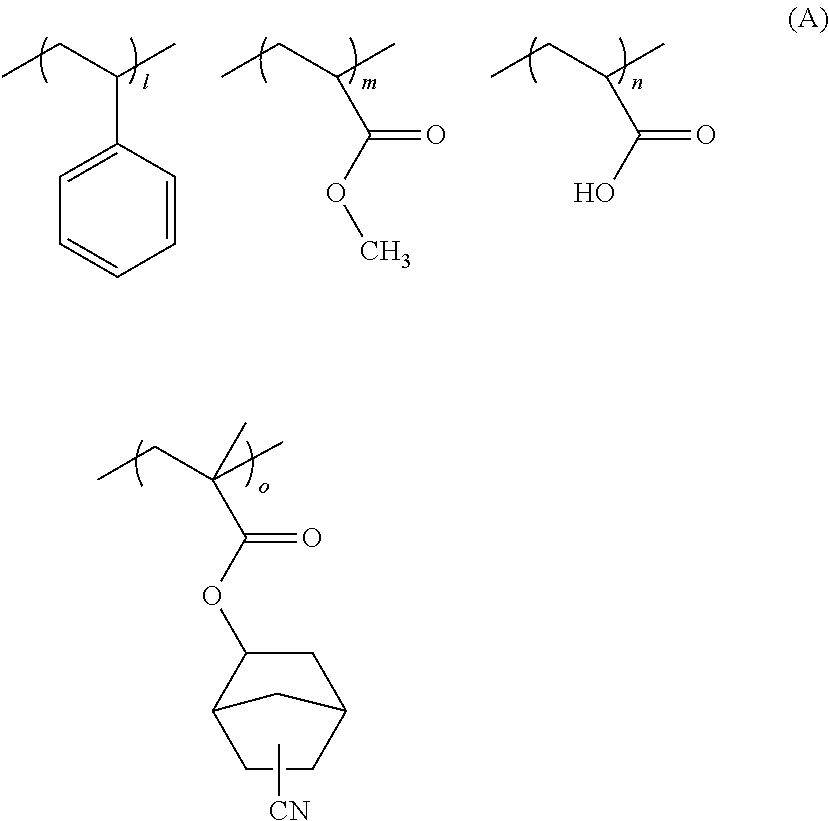Method of forming fine pattern, and developer
a technology of fine pattern and developer, applied in the field of fine pattern formation and developer, can solve the problems of difficult sequential process, difficult to realize sequential process, difficult to accurately reflect nano pattern accurately, etc., and achieve the effect of sufficient etching resistan
- Summary
- Abstract
- Description
- Claims
- Application Information
AI Technical Summary
Benefits of technology
Problems solved by technology
Method used
Image
Examples
reference example 1 and 2
[0113]After a silicon substrate was immersed in a sulfuric acid / hydrogen peroxide water mixture (volume ratio 7:3) for 1 hour, the substrate was washed with water, and then air-dried with nitrogen gas. Next, after the substrate was immersed in a toluene solution of phenethyltrichlorosilane (1.0% by mass), the substrate was heated at 250° C. for 60 seconds, and finally immersed in toluene for 30 seconds, followed by air-drying with nitrogen gas.
[0114]The substrate was spin-coated (number of rotations: 3000 rpm, 60 seconds) with a toluene solution of PS polymer (molecular weight: 90000) (17.5 mg / ml) to form a film having a film thickness of 100 nm. Then, the substrate was heated at 200° C. for 1 hour under nitrogen airflow.
[0115]Next, a portion of the substrate was irradiated with UV for 15 minutes by using an ozoneless low pressure mercury lamp (254 nm) (manufactured by SEN LIGHT Co., Ltd.). An amount of UV for exposure was 18.0 mJ / cm2.
[0116]Then each of the substrates were immersed ...
example 1 to 7
[0118]After a silicon substrate was immersed in a sulfuric acid / hydrogen peroxide water mixture (volume ratio 7:3) for 1 hour, the substrate was washed with water, and then air-dried with nitrogen gas. Next, after the substrate was immersed in a toluene solution of phenethyltrichlorosilane (1.0% by mass), the substrate was heated at 250° C. for 60 seconds, and finally immersed in toluene for 30 seconds, followed by air-drying with nitrogen gas.
[0119]The substrate was spin-coated (number of rotations: 3000 rpm, 60 seconds) with a toluene solution of PS-PMMA block copolymer 1 (molecular weight of PS: 53000, and molecular weight of PMMA: 54000; Poly dispersity index (PDI): 1.16) (17.5 mg / ml) to form a film having a film thickness of 150 to 200 nm. Then, after the substrate was heated at 110° C. for 90 seconds, the substrate on which the PS-PMMA block copolymer was coated was heated at 200° C. for 1 hour under nitrogen airflow to form the phase separated structure.
[0120]Next, the substr...
PUM
| Property | Measurement | Unit |
|---|---|---|
| vapor pressure | aaaaa | aaaaa |
| wavelength | aaaaa | aaaaa |
| wavelength | aaaaa | aaaaa |
Abstract
Description
Claims
Application Information
 Login to View More
Login to View More - R&D
- Intellectual Property
- Life Sciences
- Materials
- Tech Scout
- Unparalleled Data Quality
- Higher Quality Content
- 60% Fewer Hallucinations
Browse by: Latest US Patents, China's latest patents, Technical Efficacy Thesaurus, Application Domain, Technology Topic, Popular Technical Reports.
© 2025 PatSnap. All rights reserved.Legal|Privacy policy|Modern Slavery Act Transparency Statement|Sitemap|About US| Contact US: help@patsnap.com

